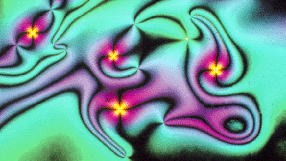

 About two-thirds of the physics faculty are condensed matter physicists.
This group has distinguished itself primarily through basic experimental
and theoretical research into the physics of condensed matter phases,
with emphasis on liquid crystal systems which can be considered as a
paradigm of the broader field. The current strength of Kent's Liquid
Crystal Institute stems primarily from research in basic and applied
physics.
About two-thirds of the physics faculty are condensed matter physicists.
This group has distinguished itself primarily through basic experimental
and theoretical research into the physics of condensed matter phases,
with emphasis on liquid crystal systems which can be considered as a
paradigm of the broader field. The current strength of Kent's Liquid
Crystal Institute stems primarily from research in basic and applied
physics.
The picture, from the laboratory of Prof. Oleg Lavrentovich (a physicist in Kent's Chemical Physics program), shows a polarizing-microscope texture of a nematic liquid crystal thin film.
For details concerning Liquid Crystal research at Kent, see the individual research descriptions for the regular physics faculty who work in this area: Allender, Finotello, Gleeson, Kumar, Lee, Mann, and Sprunt; see also the pages of the Center for Advanced Liquid Crystalline Optical Materials (ALCOM), and the Liquid Crystal Institute.
A new departmental initiative within the area of condensed matter is the study of Novel Electron Physics, including high-Tc superconductors. This research is spearheaded by Profs. Almasan, Ellman and Quader.
Facilities and techniques in condensed matter experiment include nonlinear optics, electro-optics, tunneling and atomic force microscopy, nuclear magnetic resonance, electron paramagnetic resonance, x-ray scattering, light scattering, microcalorimetry, millikelvin refrigeration, SQUID magnetometry, and magnetoresistance & Hall effect measurement.
Theoretical research in condensed matter at Kent is centered on problems in the two main areas described above, as well as independent work in computational physics, and techniques for the quantum many-body problem.
